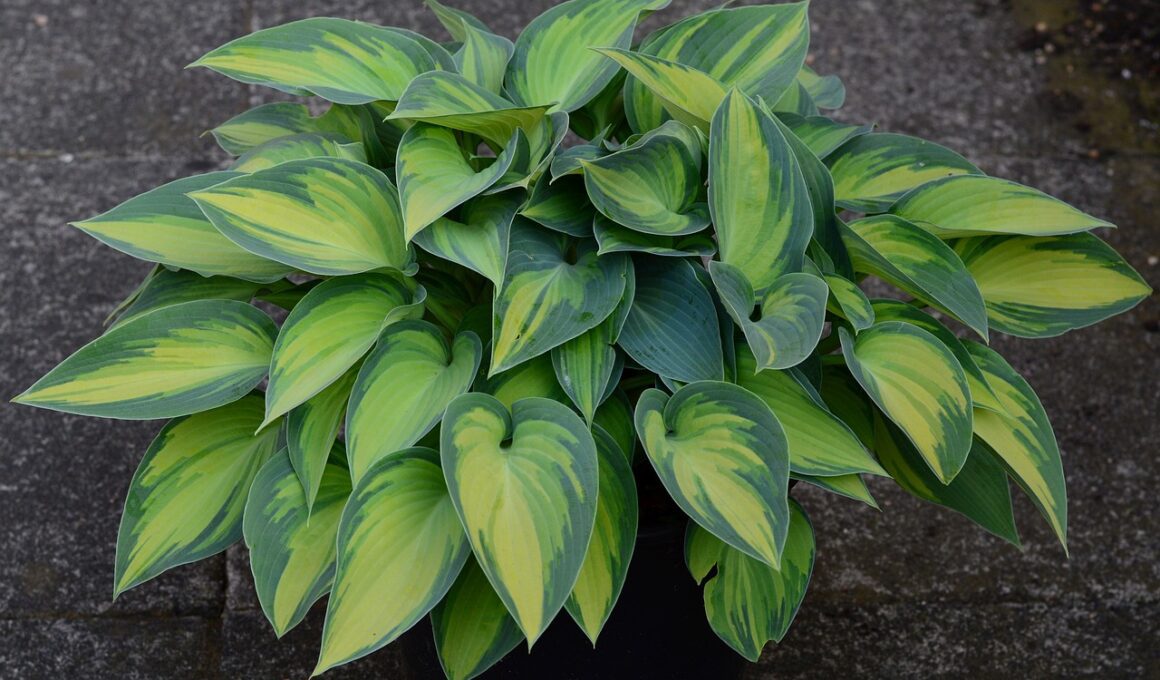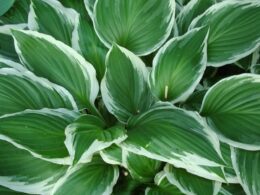Are you wondering how to properly care for your hostas during the winter months?
One important aspect of winter hosta care is knowing how far to cut them down. Cutting hostas back is an essential step in preparing them for winter, but it’s important to know the right height to cut them down to in order to ensure their survival.
Depending on your location and climate, the height at which you cut down your hostas will vary. Hostas in colder climates will need to be cut down lower than those in warmer climates. Additionally, the variety of hosta you have will also play a role in determining the appropriate cutting height.
By understanding these factors and taking the necessary precautions, you can help ensure that your hostas survive the harsh winter months and come back strong in the spring.
Consider Your Location and Climate
So, depending on where you live and the climate you experience, it’s important to take into account how your hostas will fare during the colder months. Winter hosta care is crucial to ensure that your plants survive the harsh weather conditions.
Hostas are hardy perennials, but they still need some protection during winter. To winterize hostas, start by cutting back the dead foliage in the fall. This will help prevent diseases from spreading and also make it easier to cover the plants.
You should also remove any debris that has accumulated around the plants as it can harbor pests and diseases. Once you’ve cleaned up the area, cover the hostas with a layer of mulch or leaves to insulate the roots and keep the soil moist.
It’s important to note that not all hostas are the same and some may require more protection than others. For example, hostas with thicker leaves and larger crowns may be hardier than those with thinner leaves and smaller crowns.
In areas with harsh winters, you may need to add additional protection to your hostas, such as covering them with burlap or moving them to a sheltered location. By taking the time to properly care for your hostas during the winter months, you can ensure that they thrive come spring.
Determine Your Hosta Variety
Identifying the specific type of hosta you have is crucial in determining the best way to prepare them for the colder months. Different hosta varieties have varying levels of hardiness, so it’s important to know the specific variety of hosta you have before pruning them for winter.
Once you’ve identified your hosta, you can then determine the optimal pruning method. Some hostas need to be pruned more heavily than others. For example, if you have a small hosta or a miniature variety, you can cut it down to the ground level. However, large hostas may require a different approach. In this case, you only need to remove the leaves that have turned yellow or brown.
In pruning your hostas, it’s important to keep in mind that you don’t want to cut them back too much. If you do, you may damage the crown of the plant and reduce its chances of survival. Therefore, be careful and follow the recommended pruning guidelines for your specific hosta variety. By doing so, you’ll give your hostas the best chance of thriving come springtime.
Should I Cut Down Hostas After They Finish Flowering for the Winter?
When it comes to hostas after blooming, the decision of whether to cut them down for the winter depends on personal preference. While some gardeners prefer to leave the foliage intact as a natural mulch layer, others choose to trim it down for neater aesthetics. Ultimately, it will not harm the plant either way, so it’s entirely up to you.
Decide on Your Cutting Height
When deciding on the cutting height for your hostas, there are a few factors you should consider. These include the climate you live in, the health of your hostas, and how you plan to care for them in the future.
To ensure that your hostas stay healthy and thrive year after year, it’s important to follow some simple tips for cutting them down in the winter. Remember to use sharp tools, cut at the right height, and clean up any debris to keep your hostas looking their best.
Factors to Consider When Choosing a Cutting Height
When choosing how much to trim your hostas before winter, it’s important to consider a few key factors. First, you should think about the effect on growth and aesthetics. Cutting your hostas back too much can stunt their growth and make them look less attractive come springtime. On the other hand, leaving them too long can leave them vulnerable to damage from the winter weather.
Timing is another important consideration when cutting down your hostas for winter. If you cut them back too early, they may be more susceptible to frost damage. However, if you wait too long, the foliage may become too brittle and difficult to cut.
Additionally, proper maintenance of your hostas throughout the growing season can also affect how much you need to trim them back. By keeping them healthy and well-maintained, you can avoid the need for drastic cutting come winter.
Tips for Cutting Down Hostas
Now it’s time to get your hands dirty and give your beloved hostas the TLC they need before the chilly season arrives. Proper pruning techniques are essential in ensuring that your plants can survive the winter and come back even stronger in the spring.
So, how do you properly cut down hostas for winter? Timing strategies are key when it comes to pruning hostas. You want to wait until the leaves have turned yellow and begin to wilt before cutting them down. This is because the leaves are still providing nutrients to the plant, and cutting them down too early can stunt their growth.
Once the leaves have wilted, use a sharp pair of garden shears to cut the stalks down to just above ground level. This will help prevent any disease or pests from taking hold during the winter months.
By following these simple tips, you can ensure that your hostas will thrive and provide you with beautiful foliage for years to come.
Provide Adequate Winter Protection
To ensure the health and survival of your hostas during the colder months, it’s important to provide them with adequate winter protection. Here are some tips to help you keep your hostas safe and healthy throughout the winter season:
-
Mulching techniques: Apply a generous layer of mulch, such as straw or shredded leaves, around the base of your hostas. This will help to insulate the soil and protect their roots from freezing temperatures.
-
Winter watering: Keep your hostas hydrated during the winter months by giving them a deep watering before the ground freezes. This will help to prevent dehydration and damage to the roots.
-
Covering: Cover your hostas with a cloth or burlap sack to protect them from harsh winds and freezing temperatures. This will help to prevent damage to the leaves and stems, which can cause them to die back prematurely.
-
Pruning: Cut back the dead leaves and stems of your hostas in the fall, but be careful not to cut too far down. Leave some of the stem intact to protect the crown of the plant from cold temperatures.
By following these simple tips, you can help to ensure the health and survival of your hostas during the winter months. Remember to check on them periodically throughout the season and make any necessary adjustments to their winter protection plan. With a little extra care, your hostas will thrive come springtime!
Monitor Your Hostas Throughout the Winter
Make sure to keep an eye on your beloved hostas during the colder months to ensure they stay healthy and strong. Winter care is essential to protect your hostas from the harsh conditions such as snow, frost, and cold winds. It’s critical to keep them protected from frost heaving, which can cause the roots to be exposed and damaged.
You can add a layer of mulch around the base of the plant to prevent this from happening. Pest prevention is also vital during the winter months as pests can cause significant damage to your hostas. Keep an eye out for signs of pest infestation such as holes in the leaves or damaged stems.
You can apply an insecticide or pesticide to prevent pests from causing damage to your plants. However, make sure to use non-toxic and organic products to prevent harm to other wildlife in your garden. Winter care for your hostas is a crucial aspect to ensure their health and longevity.
Monitoring them throughout the winter will help you identify any problems and take action to prevent further damage. By providing adequate protection and pest prevention, you can ensure that your hostas will thrive and continue to bring joy to your garden for years to come.
Frequently Asked Questions
Are there any hosta varieties that don’t require winter protection?
Looking for hardy hosta breeds that don’t require winter protection? You’re in luck!
There are several varieties of hostas that can withstand the colder months without any extra care. Some of these include ‘Blue Angel’, ‘Frances Williams’, and ‘Sum and Substance’.
However, if you have other hosta varieties that aren’t as cold-resistant, don’t worry! There are winter care alternatives that can help protect your plants.
One option is to cover the plants with a thick layer of mulch or leaves to insulate them from the cold. Another option is to move potted hostas indoors or into a garage or shed to protect them from freezing temperatures.
By taking these steps, you can ensure that your hostas stay healthy and thriving throughout the winter season.
Can hostas be cut down to ground level for winter?
If you’re looking to overwinter your hostas, pruning techniques can play a critical role. One common approach is to cut down your hostas to ground level for the winter. This can help protect them from harsh winter weather and reduce the risk of frost damage.
However, it’s important to be careful not to damage the crown of the plant when doing so. Additionally, you may want to consider other overwintering strategies, such as mulching or covering with a protective layer.
Ultimately, the best approach will depend on the specific needs and growing conditions of your hostas, so it’s always a good idea to consult with an expert or do some research before making any major changes.
Should I water my hostas during the winter months?
During the winter months, it’s important to continue watering your hostas despite the colder temperatures. Though they may appear to be dormant, they still require moisture to survive.
By providing them with regular watering, you’re ensuring that they stay healthy and strong, and are able to bounce back quickly once spring arrives.
In addition to watering, there are other winter care tips you can follow to help ensure your hostas thrive. For example, consider mulching around the base of the plant to help protect the roots from freezing temperatures. You can also cover your hostas with a layer of burlap or other protective material if you live in an area with particularly harsh winters.
By taking these steps, you’ll be giving your hostas the best chance of thriving come springtime.
What is the best way to protect hostas from winter pests?
Protecting your hostas from winter pests is crucial if you want them to thrive come spring.
There are two main options for winter protection: natural remedies or chemical solutions. Natural remedies include things like garlic sprays or neem oil, which can repel pests without harming the plants. Chemical solutions, on the other hand, are often more effective but can be harmful to the environment.
DIY covers made of burlap or other materials can also help protect your hostas from harsh winter weather and pests. If you’re not confident in your DIY skills, professional services are available to provide winter protection for your hostas.
Whether you choose natural remedies or chemical solutions, or DIY covers or professional services, it’s important to take action to protect your hostas from winter pests.
How often should I check on my hostas during the winter months?
Winter care for hostas is an important part of hosta maintenance. During the winter months, it’s essential to check on your hostas regularly to ensure they’re healthy and safe. Checking on them once a week is recommended.
The cold weather can cause damage to your hostas, so it’s important to keep an eye on them. You should look for any signs of damage, such as broken limbs or wilting leaves. If you notice any damage, take care of it immediately.
Additionally, you should protect your hostas from pests during the winter months by keeping the area around them clean and free from debris. Hosta maintenance during the winter months may seem like a hassle, but taking care of your plants now will ensure they thrive in the spring.
Conclusion
So, how far do you cut down hostas for winter? It really depends on your location, climate, hosta variety, and personal preference.
Some gardeners like to cut their hostas down to just a few inches above the ground, while others prefer to leave them tall for added winter interest.
Regardless of your cutting height, it’s important to provide adequate winter protection for your hostas, such as applying a thick layer of mulch or covering them with burlap.
Throughout the winter, it’s important to monitor your hostas for any signs of damage or disease. If you notice any issues, take action immediately to rectify the problem and prevent further damage.
By following these steps, you can ensure that your hostas will emerge healthy and strong come springtime. Happy gardening!








